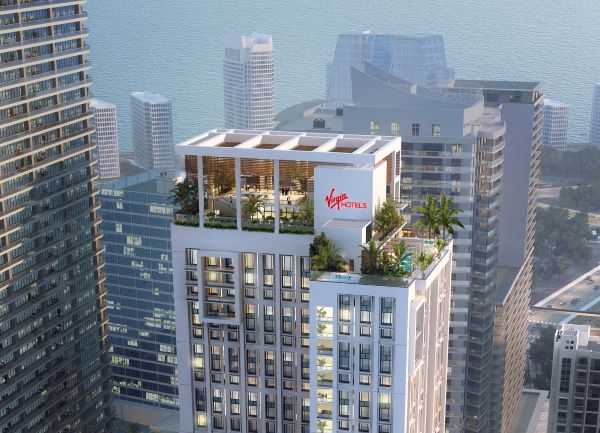One of the drawbacks of the service economy is that you can’t take it home with you. But what if you didn’t have to leave?
Hotels are the quintessential service companies: They don’t produce anything but an ephemeral experience—memorable, hopefully. At the luxury end of the spectrum, the experience is typically an indelible one—why not apply it to a residence? In branded residences, this is not only a reality, but a boon for lodging companies and owners, too.
The branded residence sector is heating up, with much of the fervor for development driven by affluent consumers who are not only looking to increase their real estate investment holdings by having a second or third home, but also the lifestyle and social status the associated hotel brands bring to the residences.
Speaking to HOTELS the day French hospitality giant Accor announced it’s looking to triple its residential footprint over the next five years, Chairman and CEO Sébastien Bazin observed that developers are equally enthusiastic for branded residence projects. “The profit they make on the real estate helps them to pay for the hotel component. For us, it’s about expanding our brand awareness, our brand service,” he said.
According to Bazin, a branded residence and a hotel room are distant cousins or closer. “Servicing an apartment is of the same manner and the same expertise as servicing a hotel room,” he said. “It’s very much synergistic and it is very important for us to shine where many people did not expect hospitality brands to invade a real estate arena.”
Accor has been doing residential for the past 10 years without people noticing it, Bazin contended, “which is why we decided to make a big push.” Accor intends to grow branded residential from 40 residences to 120 across over 12 different brands.

Tasked with bringing this to fruition is industry veteran Jeff Tisdall, chief business officer of Accor One Living, which is geared toward the development, design and operation of mixed-use projects and branded living communities. He noted that of the branded residences open, 35 are connected to a hotel, with approximately 100 in the pipeline, while five are standalone, with two in the pipeline and split 66% urban, 34% resort, respectively.
Nearly 30% of Accor’s current branded residence network is in the U.S., but Tisdall said that growth is faster internationally, with just 10% of current properties under development based in the U.S.
Within the international mix is lifestyle collective Ennismore, a JV partner of majority shareholder Accor that has a variety of branded residence projects open and under development. Included in the pipeline are three in Dubai: a standalone, 113-unit SLS Residences The Palm Dubai; a 227-unit SO/ Uptown Dubai Residences; and the world’s first Mama Shelter Residences, set to open in 2024 in the Business Bay section of Dubai.
NEW BUYER TYPES
Only a few of the Mama Shelter units remain available and the fact that the brand itself is now offering residences may surprise some. “It is new and probably unexpected,” Bazin said. “But it tells you quite a bit about the positioning of lifestyle.”
Bazin said to expect more Mama Shelter-branded residences based on the 30-year-old to 40-year-old demographic that might not be able to yet afford a high-end, luxury residence, but can at the Mama Shelter price point. “It’s best to keep catering to different clienteles,” he said.
Ennismore’s portfolio of brands appeals strongly to a new generation of branded residence purchasers, for whom the concept did not always resonate in the past, Tisdall said. “Brands like SO/, SLS and Mondrian enable us to help developers target these up-and-coming demographics and psychographics—buyers who are often prioritizing lifestyle, design, community and entertainment,” he said, pointing to Mama Shelter an example of this thinking. “Buyers are very attracted to the efficient floor plans, inspired design and the brand’s playful and vibrant personality,” Tisdall said.

Though affordable luxury may be the lure for such residence purchasers, there’s no shortage of current and potential owners who can afford pure luxury. Toward this, Accor and various partners are continuing to focus on traditional core branded residences, such as Raffles and Fairmont. Key projects include London’s The Old War Office (OWO) Residences by Raffles coming together with owners Hinduja Group and Onex Holding; Raffles Residences Boston Back Bay; Fairmont Residences Century Plaza in Los Angeles; and Fairmont Residences Royal Palm Marrakech.
“We believe New York City, Madrid, or, of course, Paris, where Accor is headquartered, would make wonderful next chapters in the evolution of our branded residence story,” said Tisdall.
A ROSY RESIDENCE

Like Accor, Rosewood Hotels & Resorts is focused on robust residential growth, seeing the number of branded residences in development more than double over the past two years, with 14 open and nine in the pipeline, including a return to its hotel brand roots in Dallas, with a 17-story, 46-unit standalone property, the Rosewood Residences Turtle Creek, scheduled to open in 2025. Units will range from approximately 2,000 square feet to 6,380 square feet and start at $3 million.
Other standalone residences set for the U.S. are Beverly Hills (17 units starting at $9 million, opening in 2024 and its first in L.A.); Lido Key, Fla. (65 units, opening in 2025); Naples, Fla. (42 units, opening in 2025); and Hillsboro Beach, Fla. (92 units, starting at $4 million and opening in 2026).
Internationally, the standalone Rosewood Residences Kamala will open with 14 units in Phuket, Thailand, in 2025.
According to Brad Berry, VP of global residential development at Rosewood Hotel Group, more than 50% of Rosewood’s existing portfolio and pipeline of upcoming hotels and resorts includes a residential component.
There are 17 Rosewood Residences that are or will be situated within or directly adjacent to a hotel or resort property, 14 of which are completed. The three under construction are: Rosewood Doha, a two-tower project in Qatar consisting of 300 residences and 173 serviced apartments set to open next year; Rosewood Residences Mandarina, developed by Mexico’s RLH, set to open in 2025 with 72 private villas in Riviera Nayarit; and Rosewood Residences Miami Beach, a 17-story tower developed by SHVO with 44 units scheduled to open next to The Raleigh hotel in 2025.
VIRGIN TERRITORY
Appealing to a younger demographic and “young-at-heart” psychographic may be just the thing needed for the recently formed Virgin Hotels Collection (currently composed of Virgin Hotels and Virgin Limited Edition), which has indicated it plans to make a foray into the branded residence space, which also will come under the VHC umbrella.
“There is a strong luxury lifestyle consumer base that has the economic means to buy this kind of real estate and is looking for a differentiated offering, with a brand that they have an affinity to,” said Greg Doman, chief development officer for Virgin Hotels. “We also have seen significant supply of traditional luxury hospitality brands in the residential vertical and believe there is significant demand for a different approach, one that emphasizes being young at heart, not taking one so seriously and one that energizes the residential experience.”
It was widely reported in 2019 that the residences launch would be part of Virgin’s 250-room, new-construction Miami hotel in the Brickell district and consist of 150 units within the 40-story building that was being developed at the time by Florida-based Blue Jay Capital, with a groundbreaking expected in 2020.
Where the project stands currently in terms of opening is unclear. “The pandemic created significant challenges to bringing new projects to market and put it under development during COVID,” Doman said. “On the upside, COVID created a post-pandemic real estate boom where both those who are looking to move or invest in key markets were seeking opportunities to purchase luxury lifestyle real estate. The pandemic slowing down the development process shifted demand and the opportunity for branded residential.”
Doman said the company is targeting urban and resort markets in locations such as Mexico, the Caribbean, Central America, the U.K. and Europe “and ones where we can leverage the branded residential units with the hotel, either stacked on top of an urban hotel/separate tower on a common podium, or adjacent villas in a resort setting.”
Unlike other lodging companies, Virgin has another ace up its sleeve: Virgin Atlantic. “Any market [it] flies to would be a market that we want to explore,” Doman said.

BEST LAID PLANS
Careful project evaluation and consideration of market is the calculus for a branded residence. “If a market is good for a hotel, it might also be good for residences, but the opposite is not always the case; there are plenty of real estate markets where we wouldn’t put a hotel, either due to zoning limitations or consumer appetite, but that might be ideal for a standalone residential opportunity,” Berry said.

For Accor, it’s also deciding which of its brands would resonate in a specific market. “Our geographic focus is really informed by three essential stakeholders: guests, homeowners and investment (development) partners,” Tisdall said. “Our success is defined by the ability of our projects to meet the requirements of these three groups. For each market, we carefully select the brand–or brands–that will optimize the performance of the hotel investments, while clearly unveiling a differentiated residential offering.”
Ensuring the brand experience is especially important with standalone projects. “Our commitment to design and planning is essential to the success of standalone branded residences,” Tisdall continued. “We find that buyers appreciate knowing that the brand and the developer have worked closely together to ensure well-structured projects that deliver exceptional hospitality services within a private residential setting.”
As example, he cited Pullman Residences Singapore, which is slated to open in 2024. EL Development is working alongside the brand to ensure that the residence director, concierge and wellness and fitness center attendants will all be directly managed, trained and supervised by Pullman.
At Rosewood, said Berry, “We build a community of residential owners and tailor experiences depending on the location. The amenities are always considered to help us provide those services, which is why these offerings are so extensive across each property.” A few examples include private dining, private shopping and wine curation.
As it expands its branded residence offerings, Hong Kong-based Mandarin Oriental Hotel Group opted for a standalone branded residence for its upcoming project in Madrid—also a first for that city—set to open in 2025. Partnering with Spain-based developer Blasson and Pictet Alternative Advisors, Mandarin Oriental is locating the 30-unit project in the city’s tony Salamanca neighborhood.
Mandarin Oriental Residences, Madrid will join standalone branded residences in Barcelona (where prices start at $2.5 million to $40-million-plus for the penthouse, which recently sold, becoming the most expensive apartment in the city), Beverly Hills (where prices start at $3.6 million for a 1,200-square-foot, one-bedroom, two-bathroom unit to $40 million for the penthouse with its own lobby, elevator and staff ) and one in New York City (with junior suites to two-bedrooms priced from $2.5 million to $15 million) developed by SHVO and set to open later this year. There are also 20 hotel-connected residences open or under development.
“Real estate is all about location, location, location—and branded residences are no different,” said Adelina Wong Ettelson, global head of residences marketing at Mandarin Oriental Hotel Group. “We put an emphasis on location when deciding where to develop standalone residences versus co-located developments.”
Ultra-high-net-worth individuals have high expectations, but when they are paying top dollar for a certain lifestyle, brands have to deliver. “Buyers of standalone residences seek a true turnkey experience with the assurance of a five-star hotel group taking care of their needs 24/7,” Wong Ettelson said.
Home is where you hang your hat and with branded residences the hat rack is extended throughout the property.
Consider an owner at Mandarin Oriental Residences Beverly Hills: “She has a three-bedroom apartment but spends much of her time using the rooftop living room space and pool area, hosting dinners and cocktails for the Super Bowl and other events,” Wong Ettelson said. Mandarin Oriental currently operates nine residences, with an additional 17 in the pipeline that include locations in Honolulu, Boca Raton and Miami in the U.S. and, internationally, the Maldives, Dubai, Da Nang, Munich, Muscat, Athens and London.

BUYER PERSONA
And just who are today’s branded residence owners?
Rosewood’s Berry indicated it depends on the market. “At our resort destinations, both the guest and buyer are typically families… for our upcoming standalone residences, many inquiries are coming from existing residents of the destination looking to make a local move or upgrade their homes,” he said.
Accor One Living ’s Tisdall commented on the spectrum of choice among branded residences; it has widened significantly,

attracting new demographics and psychographics to the sector.
As example, Tisdall noted a brand such as Swissôtel, which provides the opportunity for Swissôtel Residences that emphasize sustainability, natural materials, fitness and community bonding. “It’s a positioning and aesthetic that appeals to an increasingly powerful segment of the market,” he said. “We see this type of innovation and brand modernization continuing and we are inspired by the opportunity to help our partners spot and address niches in the market or underserved types of
homebuyers.”
Mandarin Oriental’s Wong Ettelson tags them as a mix of younger professionals looking for pieds-à-terre and fully furnished residences in metropolitan cities, as well as a mix of UHNWIs seeking co-primary and secondary homes.
“When developing our future residences, we keep in mind the trending demands for multi-functional spaces, wellness amenities, outdoor spaces, enhanced home systems and more to cater to our buyers,” she said.
Each residence at Mandarin Oriental Residences, Beverly Hills, for example, features an outdoor garden and the Grand Penthouse at Mandarin Oriental Residences, Barcelona has a customizable floor plan, “so the buyer has the final say in home design,” Wong Ettelson said.
Story contributed by Stefani C. O’Connor.
